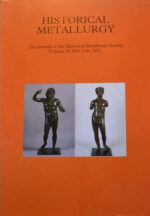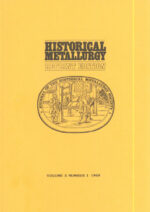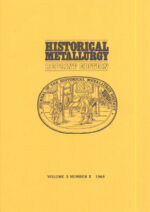Journal Contents
Agricola and the study of early metallurgy
Paul T Craddock
Pages 1-6
This paper is an appreciation of the life and work of Georgius Bauer, Agricola, on his 500th birthday, concentrating on his most famous work, De re metallica. The importance of this work to modem archaeometallurgy is assessed, together with an overview of the Renaissance world of intellectual curiosity and enquiry in which Agricola was a leading figure.
Were there medieval ironworking contacts between Sweden and Namur?
Brian G Awty
Pages 7-10
Tapping and blowing arches in adjacent sides are features which the Lapphyttan furnace in Sweden has in common with Walloon furnaces. Swedish influences perhaps predominated in Namur, where German immigrants produced steel rather than iron. Such influences arose because King Mugnus Eriksson and Count Willem I of Namur were brothers-in-law, a specific instance being the charter granted by Willem I to the ironworkers of Marche. Other contacts were the export of a large proportion of Swedish iron to Bruges via Sluys, then a lordship of the count of Namur. Further technological transfer is speculated upon.
Fordley North Park: Coke smelting in the Weald?
Jeremy Hodgkinson
Pages 11-13
The identification of an early coke-smeltrag iron furnace with one of two sites in western Sussex suggests the possible experimental use of coke in an area hitherto known only to have used charcoal. Neither documentary sources nor analysis of slag confirm this identification, which remains inconclusive.
The final phase of charcoal iron-smelting in Britain, 1660-1800
Philip Riden
Pages 14-26
New estimates of the number of charcoal-fired blast furnaces in use in Great Britain between 1660 and 1800 are combined with contemporary and inferred data for average output per furnace to produce new output series for charcoal-smelted pig for Great Britain and for twelve separate regions. The figures are compared with previous estimates and the varied experience of different regions discussed, notably the vitality of charcoal iron-smelting in South Wales immediately prior to the introduction of coke-fired furnaces there.
David Thomas: Father of the American anthracite industry
Peter N Williams
Pages 27-32
At the Yniscedwyn Iron Works at Ystradgynlais in the Swansea Valley David Thomas conducted experiments during the late 1820s to smelt iron ore using the plentiful supplies of local anthracite coal. Hearing of Nielson’s use of the hot hlast in furnaces in Scotland, Thomas tried out the new method at Yniscedwyn. By a judicious method of using the right mixture of ore and fuel, he succeed in making first class pig iron in 1837, and in so doing, played a major part in transforming the Swansea Valley into a major iron producing centre. But his greatest influence was upon the iron industry of the United States.
In Pennsylvania lay a huge anthracite coalfield waiting to be developed. News of Thomas’s success in Wales of led the directors of the newly-formed Crane Iron Company to invite him to come to Pennsylvania; David Thomas was hired for an initial period of five years. He and his family sailed in May 1839. He settled on a site near Allentown for his first furnace, running the first pig iron in 1940. Within a few short years, Pennsylvania was outstripping South Wales as the world’s largest iron producer Ten years of feverish activity, led by Thomas, completely changed the Lehigh Valley, where the iron industry, fuelled by anthracite coal, was transformed from a rural, plantation-based system into a modem, large-scale enterprise. Its importance in the industrial history of the United States can perhaps be compared to that of the Severn Valley in Britain a century earlier. Both valleys in their respective times became the world’s major centre of iron production.
The Good Old Days - memories of a laboratory melting shop
Peter Hutchison
Pages 33-37
The author describes, from memory, the work of the casting section of a metallurgical laboratory in the late 1940s.






There are no reviews yet.